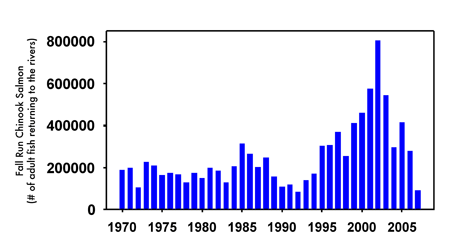Run down
Recent news headlines have been full of Chinook salmon, but sadly the same cannot be said of Central Valley waterways. This fall, only about 90,000 Central Valley Chinook salmon returned to their home rivers and streams to spawn, down from more than 800,000 just a few years ago.
Like most salmon, Central Valley Chinook are anadromous, spending the bulk of their lives in the ocean but hatching and returning to reproduce in freshwater. The journey from the Valley through the Delta and San Francisco Bay to the Pacific, and back again, has always been a long and arduous one. In the past half century it has become even more difficult as the fish have increasingly faced an obstacle course of dams, pumps, and dewatered rivers and creekbeds.
Central Valley Chinook salmon populations include four runs-winter, spring, fall, and late fall-with each spawning not only at different times of the year but in different parts of the watershed. The dawning of the age of dams hit the winter and spring runs the hardest, cutting the fish off from their historic spawning grounds in the upper reaches of the watershed. Both runs are now listed under federal and state Endangered Species Acts.

The fall run, which spawns lower in the watershed, was less impacted by dam construction. In recent decades it has numbered more than 10x all the other runs combined and has been the mainstay of the California coastal salmon fishery. Now, even it appears to be in serious trouble: The count of 90,000 salmon this year was the second lowest on record and well below the minimum conservation target of 122,000 set by the Pacific Fishery Management Council. Also alarming is that the number of 2-year-old "jacks" returning was just 2,000, down from a typical count of 40,000. Since most spawners are 3-year-olds, these early returners are considered a good predictor of the size of next year's run.
